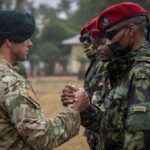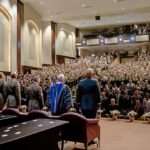
A common theme among all three leaders is that they possess certain behaviors and charisma that both their bosses and followers valued, which got them to those leadership positions.
Recently, there has been a trend of military leaders being relieved from leadership positions for unethical behaviors. These behaviors ranged from bullying subordinates, partisan views at work to severe criminal offenses like murder. For example, in April 2021, a U.S. Army colonel was relieved from his brigade command for creating a toxic work environment by bullying subordinate commanders and staff officers. The next month, a U.S. Space Force commanding officer was relieved for publicly challenging Secretary of Defense Austin’s stand down to address extremism and DoD’s diversity and inclusion initiative based on his partisan views. A telling story, however, is the Navy SEAL accused of war crimes for targeting Iraqi civilians and murdering a teenage detainee in 2017. Three of his teammates refused to testify against him in court, with one willing to go to jail rather than testifying.
A common theme among all three leaders is that they possess certain behaviors and charisma that both their bosses and followers valued, which got them to those leadership positions. Unfortunately, some of these behaviors and charismatic qualities can influence cultic practices like groupthink, as seen with the Navy SEALs’ refusal to testify against their teammate.
Dark Side of Charismatic Leadership
Led by charismatic leaders, groupthink is a phenomenon seen throughout history, from multibillion-dollar corporations like Enron to religious cults like Jonestown that ended in mass suicides. Military organizations are not immune to groupthink, unfortunately, leading to cultism if members are not aware. This short paper explores Dr. Tourish’s research on leadership and cults to identify similarities and gain insights that can be applied to future research on military cultism.
In his research, Tourish focused on the organizational culture or what he called “corporate cultism” that led to Enron’s 2001 bankruptcy. In “Charismatic Leadership and Corporate Cultism at Enron: The Elimination of Dissent, the Promotion of Conformity and Organizational Collapse”, Tourish claims that the characteristics and leadership practices of CEOs have evolved to a more cultic direction over time. These cultic dynamics may include charismatic leadership, a compelling vision, intellectual stimulation, individual consideration, and promotion of a common culture to advance a cultic leader’s goals.
There are several definitions of charismatic leadership in the literature. One emergent theme is how leaders’ charismatic qualities can influence and motivate followers through their espoused visions. These followers or “true believers,” over time, will identify themselves with the charismatic leader as a role model, which leaders can exploit positively or negatively. According to Tourish, charismatic leaders require their “followers need to believe that they come to be viewed as people of genius, insight, outstanding organizational ability and uncommon compassion, irrespective of what they actually do.” Thus, creating a perception among their followers, they can do no wrong as a leader and a desire of acceptance to be part of the group.
In cults, charismatic leadership is critical to gain followers’ trust and then manipulate the followers to further the cultic agenda. For example, Enron’s leadership overexaggerated their “powerful” image to convince followers they were more than mere employees. This aggrandizement created an illusion that they were part of something bigger than themselves; it helped convince followers to replicate leadership cultic behaviors, suppressing their internal voices, to potentially achieve similar successes someday. Therefore, the proliferation and normalization of the cultic leader’s skewed vision influenced conformity throughout the organization.
A leader’s vision sets forth a belief system required to achieve long-term goals. Like all charismatic leaders, a cultic leader convinces followers that, through their vision, it is possible to achieve goals beyond the average competitor. For instance, Enron’s vision promised employees unimagined wealth and happiness if they met their organizational goals. Thus, Enron’s vision, combined with the example set by their wealthy and charismatic leadership, persuaded followers into believing that they were part of an exclusive, elite and privileged group.
Charismatic Leadership at Enron
Those at Enron who trusted in this vision were committed to working at an almost cultic level. Tourish wrote that, “Employees sacrificed their today in the hope of a better tomorrow.” Thus, followers’ lives revolved around work, providing them with intellectual stimulation and a sense of purpose. This overcommitment, however, blurred the perception of their personal and professional selves.
In pursuit of this vision, followers slowly transformed, allowing the organization to drive their sense of purpose and belonging in life, and Collinson suggested that this overcommitment to work encouraged people to “treat all organizational, social and even personal relations as instrumental to career progress.” Thus, the cultic leader’s vision influenced the lives of Enron followers to fully revolve around work and its associated priorities. Tourish states that those who adopt this mindset are “more liable to escalate their commitment beyond any point of rationality,” such as by making immoral or unethical decisions to meet a cultic leader’s organizational goals.
Before followers’ unbounded commitment to an organization, individual consideration is used for recruitment and indoctrination. According to Tourish, a cult’s recruiting process usually includes “intense and emotional” rituals to expose prospects to a leader’s insights, and adopting behaviors they usually would not approve. For example, Enron had potential recruits attend second interviews on “Super Saturdays,” where interviewees went through rigorous 50-minute interviews with eight different interviewers. This pressure compelled prospects to demonstrate to their interviewers that they were true believers in the company’s vision, even if they had doubts. Consequently, according to Tourish, new employees who were compliant over time became “liable to internalize the values behind the ritual – even if they have initially resisted them.” Thus, these repetitive rituals planted the seed for new prospects to begin the cultic conversion process.
Enron’s intense selection process demonstrated the demanding work environment, which required high levels of commitment from their employees. This indoctrination process, combined with excessive positive attention from leaders, made prospects feel part of the team and intensified the need to express their support to the organization’s vision. However, this indoctrination process became the norm throughout an employee’s time at Enron. Tourish stated that “The further one ascended the hierarchy, the more one was exposed to it.” Thus, groupthink began on day one and continued throughout one’s career at every level. This groupthink may have promoted a perception of a common culture; however, any corrective feedback or perceived challenge to corporate norms was viewed as dissent.
Thus, the cultic leader’s vision is absolute; anyone who challenges it is pushed out of the organization.
Organizational culture and climate are typically set by senior leadership. For these reasons, cultic leaders are able to establish an organizational culture aimed at their cultic goals with minimal to no input from their followers. Tourish noted that “The ideal state is one of monoculturalism, in which differences from the vision of the leader is banished to the margins of the group’s tightly policed norms.” Thus, the cultic leader’s vision is absolute; anyone who challenges it is pushed out of the organization. This creates an organizational culture based on groupthink and uncertainty, as true believers begin to seek those who disagree with a leader’s vision.
Enron established a punitive culture to remove dissenters and low performers through their appraisal system called “rank and yank.” The “rank and yank” system divided employees into three groups: ‘A’s, who were to be challenged and given large rewards; ‘B’s, who were to be encouraged and affirmed, and ‘C’s, who were told to shape up or ship out. According to Tourish, those in the bottom two categories felt the perpetual pressure of potentially losing their jobs, contributing to a cutthroat culture. Fusaro and Miller summarized it best in “What Went Wrong at Enron: Everyone’s Guide to the Largest Bankruptcy in U.S. History”
It is clear that Enron’s management regarded kindness as a show of weakness. The same rigors that Enron faced in the marketplace were brought into the company in a way that destroyed morale and internal cohesion. In the process of trying to quickly and efficiently separate from the company those employees who were not carrying their weight, Enron created an environment where employees were afraid to express their opinions or to question unethical and potentially illegal business practices. Because the rank-and-yank system was both arbitrary and subjective, it was easily used by managers to reward blind loyalty and quash brewing dissent.
This created a culture of survival and conformity to ensure followers stayed ahead of their peers. Moreover, those who did not perform or who expressed a sense of dissent were removed from the organization. Tourish wrote that “The rank and yank system, therefore, pitted employees against each other. It was clearly in every individual’s interest that someone other than themselves received a poor rating. This created a strong incentive to provide poor evaluations for others while simultaneously seeking positive evaluations for oneself.” This curated culture therefore created persistent stressors and anxiety as followers worked in constant fear of getting “cut.”
Significantly, this stress pushed Enron employees to ignore unethical practices in fear of losing their careers. Tourish quoted a senior employee who said, “There was an unwritten rule… a rule of ‘no bad news.’ If I came to them with bad news, it would only hurt my career.” Demonstrating how Enron’s cultic leaders created a culture of conformity and groupthink, which incentivized followers to ignore unethical and fraudulent behavior in fear of losing their job. Similarly, in “Lying to Ourselves: Dishonesty in the Army Profession”, Wong and Gerras found that Army leaders could not meet all the requirements forced on them by higher echelons in garrison and while deployed. As a result, it transformed their values and behaviors to rationalize unethical practices such as lying on Unit Status Reports (USR) or assessments reports of partner forces in Iraq and Afghanistan to appease senior commanders and for their own career advancement.
Implications for the Military
Dr. Tourish’s research provides an excellent example of how charismatic leadership with immoral intentions can form organizational cultism. Combining this charisma with a compelling vision, intellectual stimulation, individual consideration, and promotion of a common culture, if implemented unethically, can incentivize conformity and create groupthink as freethinkers are seen as dissenters. Like the corporate cultism exhibited at Enron, military organizations are also vulnerable to the military cultism cycle. And once in this cycle, it is difficult to stop as those who challenge it are usually hung out to dry, as seen at Enron.
The topic of charismatic leadership in the military is not new, but there is minimal scholarly research on military cultism. As the new cohorts for the U.S. Army War College and the U.S. Army Command and General Staff College arrive this summer, this could be an opportunity to explore further the relationships between charismatic leaders and cultism within military organizations. As former U.S. Army Special Forces Operator and author Jack Murphy wrote in 2014: “By forming cults, we close our minds off to new ideas, making the bureaucracy more bureaucratic. We become rigid and inflexible, a trait that our enemies use to their advantage. We force out risk-takers and innovators, exchanging them for our own unique brand of groupthink.”
Assad Raza is an active-duty U.S. Army Civil Affairs officer serving at the Western Hemisphere Institute for Security Cooperation (WHINSEC). He holds a Bachelor of Art in psychology from the University of Tampa, a Master of Art in diplomacy with a concentration in international conflict management from Norwich University, and a Master of Military Art and Science from the U.S. Army Command and General Staff College.
The views expressed in this article are those of the author and do not necessarily reflect those of the U.S. Army War College, the U.S. Army, or the Department of Defense.
Photo Credit: Business photo created by d3images – www.freepik.com





There is a very thin line between good and bad charisma…Not to wear out the comparisons so often made of Dick Winters and Easy Company BUT… He had charisma. His was good… He lead by good example and ensured all who worked with him understood that and did the same… That is LEADERSHIP…..Carnival barkers have charisma but they are just conning you into their game and you out of your money…. It always comes down to POWER… Some use every trick to amass power…..Some find themselves in positions where they are powerful and use it for the common good….. The importance for military leaders (and also non-military) is to know the difference.. This is another aspect of your moral compass…Thanks for the thought provoking article…
Ralph Reed was Enron’s latter day advisor, & one of his early biz consulting clients, along with Koch & various rightwing political campaigns.
He was too corrupt for Microsoft, who dumped him. He has advised the money groups backing (& benefiting from) Netanyahu & other foreign autocrats, as well as of course domestic, being a recent President’s “evangelical advisor.”
He’s expert at expanding & directing religious groups, gun lobby & military figures for biz/political gain.
Knowing how to flatter, coerce & morally compromise people is a lucrative “strategy” to any “leader,” visible or backroom, whose goal is Being Served by the common good. Not Serving the common good. Ironically, the pure opposite of a “Christian Value.”